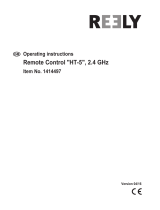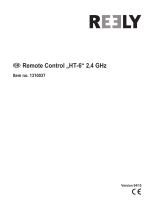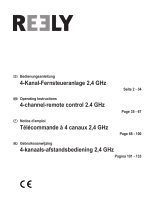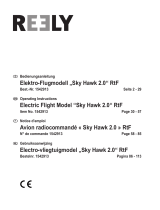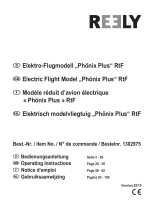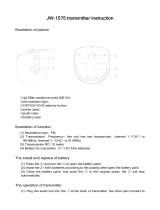Page is loading ...

( Remote Control „HT-4“ 2.4 GHz
Item no. 1310036
Version 03/15
7

2
Table of Contents
Page
1. Introduction ..........................................................................................................................................................3
2. Explanation of Symbols .......................................................................................................................................3
3. Intended Use .......................................................................................................................................................4
4. Product Description .............................................................................................................................................4
5. Scope of Delivery .................................................................................................................................................4
6. Safety Information ................................................................................................................................................5
a) General Information .......................................................................................................................................5
b) Operation .......................................................................................................................................................5
7. Notes on Batteries and Rechargeable Batteries ..................................................................................................7
8. Charging Rechargeable Batteries ........................................................................................................................7
9. Transmitter Controls ............................................................................................................................................8
10. Setting up the Transmitter ....................................................................................................................................9
a) Inserting the Batteries ....................................................................................................................................9
b) Switching on the Transmitter .........................................................................................................................9
c) Setting the Control Stick Length ..................................................................................................................10
11. Setting up the Receiver .....................................................................................................................................10
a) Connecting the Receiver .............................................................................................................................10
b) Mounting the Receiver ................................................................................................................................. 11
12. Installing the Servos ..........................................................................................................................................12
13. Setting the Trim ..................................................................................................................................................13
14. Checking the Servo Directions of Travel ............................................................................................................14
15. Switching the Servo Directions of Travel ...........................................................................................................16
16. Changing the Control Stick Allocation ................................................................................................................17
17. Delta Mixer .........................................................................................................................................................18
18. Switching the Digital Code .................................................................................................................................19
19. Binding Function ................................................................................................................................................20
20. Simulator/Student Transmitter Function ............................................................................................................21
21. Maintenance and Care ......................................................................................................................................21
22. Declaration of Conformity (DOC) .......................................................................................................................21
23. Disposal .............................................................................................................................................................22
a) General Information .....................................................................................................................................22
b) Batteries and Rechargeable Batteries .........................................................................................................22
24. Troubleshooting .................................................................................................................................................23
25. Technical Data ...................................................................................................................................................24
a) Transmitter...................................................................................................................................................24
b) Receiver ......................................................................................................................................................24
(

3
1. Introduction
Dear Customer,
thank you for purchasing this product.
This product complies with the statutory national and European requirements.
To maintain this status and to ensure safe operation, you as the user must observe these operating instructions!
These operating instructions are part of this product. They contain important notes on commissioning and
handling. Also consider this if you pass on the product to any third parties.
Keep these operating instructions for future reference!
All company names and product names are trademarks of their respective owners. All rights reserved.
If there are any technical questions, please contact:
International: www.conrad.com/contact
United Kingdom: www.conrad-electronic.co.uk/contact
2. Explanation of Symbols
The symbol with the exclamation mark points out particular dangers associated with handling, function or
operation.
The „arrow“ symbol indicates special advice and operating information.

4
3. Intended Use
The 4-channel remote control „HT-4“ is solely designed for private use in the eld of model construction and the
operating times associated with it. This system is not suitable for industrial use, such as controlling machines or
equipment.
Any use other than that described above can damage the product and involves additional risks such as short circuit,
re, electric shock, etc. The product must not be technically changed or converted! The safety information must be
observed at all times!
Observe all safety information in these operating instructions. They contain important information on hand-
ling of the product.
You are solely responsible for the safe operation of your remote control and your model!
4. Product Description
The 4-channel remote control system „HT-4“ is a radio control system that is mainly ideal for controlling model planes.
If necessary, the remote control can also be used to control model vehicles, model ships or simple 4-channel model
helicopters (speed-controlled).
The four proportional control channels can be used to remote-control the different control functions independently of
each other. The ergonomic casing ts comfortably into your hand and allows for easy and safe operation of the model
and the transmitter.
For operation, 4 AA/mignon batteries (e.g. Conrad item no. 652507, pack of 4, order 1x) are required for the trans-
mitter.
Where no ight controller with BEC switch is used, you also need 4 AA/mignon batteries for the receiver (e.g. Conrad
item no. 652507, order once) or 4 AA/mignon rechargeable batteries with the corresponding battery holder. Alter-
natively, 4- or 5-cell NiMH receiver batteries (rated voltage 4.8 - 6.0 V) can also be used with the switch cable. The
receiver may also be operated with a 2-cell LiPo battery (rated voltage 7.4 V), but the connected servos also must be
high-voltage-capable.
5. Scope of Delivery
• Remote Control Transmitter
• Remote control receiver
• Binding plug
• Operating instructions on CD

5
6. Safety Information
The guarantee/warranty will expire if damage is incurred resulting from non-compliance with these
operating instructions. We do not assume any liability for consequential damage!
We do not assume any liability for property damage and personal injury caused by improper use or
non-compliance with the safety instructions! In such cases the warranty/guarantee is voided.
Normal wear and tear in operation and damage due to accidents (like the receiver aerial being torn off, the
receiver casing broken etc.) are excluded from the warranty.
Dear customer, these safety instructions are not only for the protection of the product but also for your own
safety and that of other people. Therefore, read this chapter very carefully before taking the product into
operation!
a) General Information
• The unauthorised conversion and/or modication of the product is prohibited for safety and approval reasons (CE).
• This product is not a toy and not suitable for children under 14 years of age.
• The product must not get damp or wet.
• Taking out private liability insurance is recommended. If you already have one, get some information on whether or
not the operation of a radio-operated model is covered by your insurance.
• Do not connect the drive motor to electric models before the receiver system has been installed completely. This
ensures that the drive motor does not start unintentionally.
• Do not leave packaging material unattended. It may become a dangerous toy for children.
• Please check the functional safety of your model and of the remote control system each time before you use the
model. Watch out for any visible damage such as defective plug connections or damaged cables. All movable parts
on the model have to be running smoothly. However, there must be no tolerance or ‚play‘ in the bearing.
• The operation and handling of RC models must be learned! If you have never controlled such a model, start espe-
cially carefully to get used to how it responds to the remote commands. Do be patient!
• Should questions arise that are not answered with the help of this operating manual, contact us (contact information,
see chapter 1) or another expert.
b) Operation
• If you do not yet have sufcient knowledge on how to deal with remote-controlled models, please contact an expe-
rienced model sportsman or a model construction club.
• When putting the device into operation, always turn on the transmitter rst. Then switch on the receiver in the model.
Otherwise, the model might show unpredictable responses!
• Avoid directing the tip of the aerial directly towards your eyes. The range reduces strongly.
• Before operating the model, check whether the stationary model reacts as expected to the commands of the remote
control.

6
• When you operate the model, always make sure that no parts of your body, other people or objects come within the
dangerous range of the motors or any other rotating drive parts.
• Improper operation can cause serious damage to people and property! Always make sure that the model is in your
line of sight and do not operate it at night.
• Only operate your model if your ability to respond is unrestricted. Fatigue or the inuence of alcohol or medication
can lead to wrong responses.
• Operate your model in an area where you do nor endanger any persons, animals or objects. Only operate it on
private sites or in places which are specically designated for this purpose.
• In case of a fault stop operating your model straight away and remove the cause of malfunction before you continue
to use the model.
• Do not operate your RC system during thunderstorms, beneath high-voltage power lines or in the proximity of radio
masts.
• Never switch off the remote control (transmitter) while the model is in use. To switch off the model, always switch off
the motor rst, then switch off the receiver. Only then may the remote control be switched off.
• Protect the remote control from dampness and heavy dirt.
• Do not expose the remote control to direct sunlight or excessive heat for a long period of time.
• If the batteries in the remote control are low, the range decreases. If the receiver batteries or rechargeable battery
in the receiver are low, the model will not respond correctly to the remote control.
If this is the case, stop driving immediately. Replace the batteries with new ones or recharge the receiver‘s rechar-
geable battery.
• Do not take any risks when operating the product! Your own safety and that of your environment depends completely
on your responsible use of the model.

7
7. Notes on Batteries and Rechargeable Batteries
• Keep batteries/rechargeable batteries out of the reach of children.
• Do not leave any batteries/rechargeable batteries lying around openly. There is a risk of batteries being swallowed
by children or pets. If swallowed, consult a doctor immediately!
• Batteries/rechargeable batteries must never be short-circuited, disassembled or thrown into re. There is a danger
of explosion!
• Leaking or damaged batteries/rechargeable batteries can cause chemical burns to skin on contact; therefore, use
suitable protective gloves.
• Do not recharge normal batteries. There is a risk of re and explosion! Charge only rechargeable batteries intended
for this; use suitable chargers.
• Always observe correct polarity (positive/+ and negative/-) when inserting the batteries/rechargeable batteries.
• If the device is not used for an extended period of time (e.g. storage), remove the inserted batteries/rechargeable
batteries from the remote control and the car to avoid damage from leaking batteries/rechargeable batteries.
• Recharge the rechargeable batteries about every 3 months. Otherwise, so-called deep discharge may result, ren-
dering the rechargeable batteries useless.
• Always replace the entire set of batteries or rechargeable batteries. Never mix fully charged batteries/rechargeable
batteries with partially discharged ones. Always use batteries or rechargeable batteries of the same type and manu-
facturer.
• Never mix batteries and rechargeable batteries!
• For reasons of operational safety,only use batteries and rechargeable batteries for the remote control transmitter.
8. Charging Rechargeable Batteries
If you use rechargeable batteries for power supply of the receiver, they are usually at at delivery and must be
charged.
Note:
Before a rechargeable battery reaches maximum capacity, several complete discharge and charge cycles
are necessary.
Always discharge the rechargeable battery at regular intervals, since charging a „half-full“ rechargeable bat-
tery several times can cause a so-called lazy battery effect. This means that the rechargeable battery loses
capacity. It no longer provides all of its stored energy, and the operating time of the model is reduced.
If you use several rechargeable batteries, purchasing a high-quality charger may be worthwhile. Such a
charger usually has a quick-charging feature.

8
9. Transmitter Controls
Figure 1
1 Transmitter aerial
2 Carrying handle
3 Trim button for elevator function
4 Control lever for elevator and aileron function
5 Trim button for aileron function
6 LED Display
7 On/off switch
8 Reverse switch
9 Delta mixer switch
10 Binding button
11 Trim button for rudder function
12 Control lever for rudder and motor function
13 Trim button for motor function
14 Carrying belt eyelet

9
10. Setting up the Transmitter
In the further course of these instructions, gures in the text always refer to the adjacent gure or the gures
within the section. References to other gures are indicated with the corresponding gure number.
a) Inserting the Batteries
For the power supply of the transmitter you will need 4 alkaline
batteries (e.g. Conrad item no. 652507, pack of 4, order 1) of
the size AA/mignon.
Proceed as follows to insert the batteries:
The battery compartment lid (1) is located on the back of the
transmitter. Press the corrugated area (2) and push off the lid
downwards.
Ensure that the polarity is correct when inserting the 4 batteries.
A corresponding note (3) is located on the bottom of the battery
compartment.
Then slide the lid of the battery compartment back on from the
bottom until the locking mechanism engages.
b) Switching on the Transmitter
When new batteries are inserted, switch on the transmitter with
the function switch (see gure 1, item 7) for test purposes. For
this, slide the operating switch from the bottom (off) to the top
(on).
The transmitter emits a short signal sound and the LED display
(also see gure 1, item 6) lights up green permanently.
If the voltage supply drops below 5 V, the LED display switches from green to orange to red and thus indicates threa-
tening undersupply of the transmitter. The model should then no longer be operated.
When the voltage drops below 4.2 V, the LED display starts ashing red and the transmitter emits acoustic warning
sounds at regular intervals. In this case, operation of the model must be ceased as quickly as possible. Insert new
batteries for further operation of the transmitter.
After you have veried the correct function of your transmitter, switch it off again.
Figure 2
Figure 3

10
c) Setting the Control Lever Length
You can adjust the length of the control sticks, depending on
your steering habits.
To do so simply hold the bottom part of the grip (1) and turn the
upper part (2) up anti-clockwise.
You can now set the length of the control stick by turning the
bottom part of the grip.
Finally, tighten the upper part of the grip back up.
11. Setting up the Receiver
a) Receiver Connection
The receiver offers the possibility of connecting 4 servos (recei-
ver output „CH1“, „CH2“, „CH3“ and „CH4“) that are later assig-
ned the following control functions in the model:
„CH1“ = Aileron/roll servo
„CH2“ = Elevator/nod servo
„CH3“ = Throttle servo or ight/drive controller
„CH4“ = Rudder/tail servo
The receiver outputs „CH5“ and „CH6“ are not used, since the
transmitter only transmits the rst four channels.
At the „BAT“ connection, a battery box (1) or a receiver battery
with switch cable (2) is connected if no ight/speed controller
with BEC switch is used.
Important!
When using servos with high power demand, we recommend that you always use a high-current-capable
receiver battery pack.
Figure 5
Figure 4

11
The connections are designed for JR plug connectors. If required, Futaba plugs can be used as well, if a key le or a
sharp knife is used to remove the narrow guide bridge at the plug.
When connecting servos and speed controllers, always make sure of correct polarity of the plug connectors. The plug-
in connection for the positive lead (yellow, white or orange, depending on the manufacturer) must be connected to the
inner (left) pin contact. The plug-in connection for the negative lead (black or brown, depending on the manufacturer)
must be connected to the outer (right) pin contact.
First, switch on the transmitter and then the receiver. If the binding function is working correctly, the red LED indicator
in the receiver (see gure 5, item 3) lights up and the four servos react to the movements of the control levers. Verify
correct receiver function and then switch the receiver off again.
If the servos do not react and the LEDs in the receiver do not light up, perform binding (see chapter 19).
b) Installing the Receiver
Installation of the receiver depends on the model. For this reason, you should always follow the recommendations of
the model manufacturer regarding the installation.
Regardless of the model, you should always try to install the receiver so that it is protected from dust, dirt, moisture,
heat and vibration in the best possible way.
Keep enough distance from motors and electronic ight or speed controllers. Metal or carbon parts have a shielding
effect and thus may considerably impair reception. In this case, it is sensible to relocate the aerial outwards through
a bore in the fuselage.
Two-sided adhesive foam (servo tape) or rubber rings that hold the foam-wrapped receiver securely in place are
suitable for fastening.
Attention!
The aerial wire (1) length is determined precisely.
For this reason, you must not roll up the wire, place it
in a loop or cut it off. This would decrease the range
signicantly and thus pose a considerable safety risk.
Figure 6

12
12. Installing the Servos
The installation of a servo (1) always depends on the particular
model used.
Detailed information on this can be found in the construction
documents of the model.
Generally, however, try screwing in the servos in a vibration-
dampened manner. This is why rubber bushings (2) with metal
sleeves (3) are usually included with the servos.
When servos are obstructed, the servos cannot assume the required positions. This causes higher power consumpti-
on and the model cannot be controlled properly. The linkages must work as smoothly as possible without having any
play in the bearings or deections.
Before installing the servo lever, take the transmitter and then
the receiver into operation and check the trim at the remote
control transmitter for correct middle position (see following
chapter).
Then always mount the servo stick at a 90° angle to the linkage
rods (see gure 8, sketch A).
The servo lever is at an angle to the linkage rod (see gure 8,
sketch B), the control paths of the two control directions will be
unequal.
A slight mechanical inclination due to interlock of the servo le-
vers may be corrected with the trim later.
Figure 8
Figure 7

13
13. Setting the Trim
The trim mostly serves to correct the slight inclination of the servo levers due to the interlock and the connected
irregular control movements.
Additionally, there is the option to adjust the model in operation precisely, e.g. if it is not ying straight although the
control lever is in the middle position.
Then the linkage or rudder rods must be adjusted so that the trim has its original value (90°-range between servo lever
and linkage) again and the model still runs straight.
The remote control „HT-4“ has a nely tuned digital trimming
with which each control channel can be individually set with a
trimming button (also see gure 1, items 3, 5, 11 and 13).
The trimming buttons are assigned the following control func-
tions:
3 Trimming button for elevator servo „CH2“
5 Trimming button for aileron servo „CH1“
11 Trimming button for aileron servo „CH4“
13 Trimming button throttle servo „CH3“
To check the setting of the digital trimming, rst switch on the transmitter and then the receiver. If a trimming button is
moved to the side or up or down and held, the transmitter will emit brief signal sounds in a quick sequence. The servo
of the respective control channel will change the position of the servo lever in small steps.
When the end of the trimming range is reached, the signal sounds go out and the servo lever stops turning. If the
trimming button is then deected in the opposite direction and held, the signal sounds sound again and the servo lever
turns back to the middle position step by step.
When the middle position of the trimming range has been reached, the remote control issues a longer signal sound.
Now set the middle positioning of the trimming in all four channels and install the servo levers so that they are at a
90° angle to the rods. Since the servo levers and the servo axis are interlocked, very small inclinations of the servo
lever cannot always be avoided. In this case, the trimming of the respective channel must be adjusted slightly from the
middle to return to the 90° angle of the servo lever to the linkage rod (see gure 8).
The set trim value is automatically saved in the remote control and is retained even after switching it off and
on.
When using the electrical model with a ight controller, the trim for channel 3 also needs to be set to the
middle value.
Figure 9

14
14. Checking the Servo Directions of Travel
Connect the servos inserted in the model to the receiver. Pay attention to the assignment of the receiver outputs as
described above.
If your model has two aileron servos, there is the possibility of operating both servos with a V-cable at the
receiver output „CH1“.
Take the transmitter into operation, then the receiver. If attached correctly, the servos at outputs 1, 2, 3 and 4 should
react in the right direction to the movements of the control levers according to the illustrations in gure 10. The linkage
rods of the rudders must be adjusted so that the rudders are all aligned precisely centrally if the control lever and the
trimming are in the central position (also see top sketch in gure 10).
The next page, gure 10, shows a schematic illustration of the rudder deections in the respective control lever
movements.
The left control lever for motor control can be pushed forward and back without being moved back to the
middle position by spring force. It always remains in the position into which it was last moved.
An electronic motor controller connected at the receiver output „CH3“ must be set so that an electric motor is off when
the left control lever is in the bottom position. If the model is operated with a combustion engine, the throttle servo
linkage must be adjusted so that the motor runs idle when the carburettor is nearly closed. Only when the trim for the
motor function is also pushed all the way to the bottom, the carburettor must close completely so that the combustion
engine is switched off.
If the control lever is pushed to the top-most position, the throttle in the carburettor must be completely opened so that
the motor can run at full power.
For electrical models, the ight controllers often offer the option to teach in the respective positions for motor off and
maximum performance. Further information on this can be found in the operating instructions of the ight controller.
Attention!
Only perform the motor test in an electric model when the model is reliably secured against rolling away.
Make sure that neither objects nor body parts are in the rotating and suction areas of the propeller during
the motor test.
If the servos or rudders react in precisely the opposite manner as shown in gure 10, the reverse switches (see follo-
wing chapter) can swap the running direction of the respective servo.
Important!
Always switch on the transmitter rst, then the receiver. When you switch off the devices, always switch off
the receiver rst, then the transmitter.
Never switch off the remote control as long as the receiver is in operation. This can lead to unexpected
reactions by the model!

15
Figure 10

16
15. Switching the Servo Directions of Travel
If the rudder movements are not according to gure 10, you
can switch the running direction of every single servo with the
reverse switches (also see gure 1, item 8). The switches are
assigned as follows:
„AIL“ = Aileron/roll servo
„ELE“ = Elevator servo
„THR“ = Throttle servo/ight controller
„RUD“ = Rudder/tail servo
If the switch is in the bottom position, the „regular“ running direc-
tion is set. If the switch is pushed to the top position, „reversed“
running direction is activated.
Observe that the centre position of the servo/rudder may have to be adjusted after switching.
Figure 11

17
16. Changing the Control Stick Allocation
If you want to control your ight model according to the chart shown in gure 10 (mode II), you an skip this section.
If you prefer the throttle function on the right control lever and the elevator function on the left one (Mode I), you may
convert the transmitter accordingly.
To make the necessary changes, some experience with remote control transmitters is required. Therefore you should
consult an experienced model maker or a model construction club if you do not feel capable of undertaking the pro-
cedures described in the following.
Proceed as follows:
• Remove the transmitter batteries.
• Unscrew the four screws by means of a Phillips-tip screwdriver from the rear panel of the transmitter and lift the rear
panel carefully.
• After you have disconnected the plug connector of the student socket (1), you can fold the rear of the transmitter
down.
Figure 12
• For this, loosen the four screws at the control lever units (2) and swap the two units. You need to turn the control
lever units by 180° each so that the connections of the control lever potentiometers (3) are aligned to the inside
again.
• Then screw on the control lever units again.
• Use pointed pliers or pincers to pull the jumper (4) from the position „L“ and reinsert it in position „R“.
• Then close the connection plug of the student socket again and place the rear panel on the transmitter housing.
• Turn in the four attachment screws.
• Insert the transmitter batteries and check for correct function of the remote control.

18
17. Delta Mixer
The remote control „HT-4“ has a delta mixer that can be activated with the mixer switch (also see gure 1, item 9).
When the slider is in the bottom position, regular operation without mixer function is active. When the slider is put up,
the delta mixer is activated.
For a delta plane model with triangular wing, the ailerons also have to perform the elevator function. For this reason,
the channels „CH1“ (aileron) and „CH2“ (elevator) are mixed in the delta mixer. Independently of whether the transmit-
ter controls the aileron or elevator function then, the two servos at the receiver outputs „CH1“ and „CH2“ will always
react at the same time then.
The servo of the right wing has to be connected to the receiver output „CH1“ and the servo of the left wing to the
receiver output „CH2“. The deections of the two rudder aps have to be according to the gures in gure 13.
If required, the servo directions can be corrected with the reverse switches (see chapter 15).
Figure 13

19
18. Switching the Digital Code
The remote control transmitter enables you to control receivers with the digital code „AFHDS“ and „AFHDS2A“. Ex
works, the transmitter is set to the enclosed „AFHDS2A“-encoded receiver.
If you want to operate a REELY receiver with the digital code „AFHDS“, the transmitter must be switched rst and then
the receiver must be bound to the transmitter (see following chapter).
To switch the digital code at the transmitter, proceed as follows:
• Switch off the transmitter.
• Move the two control levers to the lower left corner and keep it
there.
• Switch on the transmitter with the on/off switch with the control
levers deected.
• Release the two control levers so that they move to the centre
position.
• If the LED display ashes, the transmitter has switched to
the digital code „AFHDS“. If the LED display ashes and the
remote control also issues short signal sounds in a cycle of
one second, the transmitter has switched to the digital code
„AFHDS2A“.
• Switch off the transmitter so that the currently set digital enco-
ding is saved.
Important!
The receiver enclosed with the remote control system „HT-4“ works with code „AFHDS2A“. Therefore, al-
ways observe that the right code is programmed at the transmitter!
Figure 14

20
19. Binding Function
To enable transmitter and receiver to work together, they must be bound by the same digital code. In the delivery state,
transmitter and receiver are aligned with each other and can be used at once. The binding settings must be renewed
mainly after a replacement of the transmitter or receiver or to remove any interferences.
Before you can bind the receiver to the transmitter, check if the transmitter works in the right digital code (see previous
chapter).
To perform the binding procedure, proceed as follows:
• Transmitter and receiver must be in direct proximity (distance
approx. 50 cm).
• Switch off the transmitter.
• Disconnect any servos that may be connected from the recei-
ver.
• Connect the enclosed programming plug (1) to the „BAT“ con-
nection of the receiver.
• The power supply of the receiver (receiver battery or speed
controller with BEC) is connected to any output of the recei-
ver.
• Switch on the receiver. The receiver LED (2) starts to ash
quickly.
• Press the binding button at the receiver (see also gure 1, item
10) and keep the button pressed.
• Switch on the transmitter with the on/off switch with the binding
button pushed. The LED display in the transmitter starts to
icker.
• When the LED in the receiver (2) ashes slowly after a few
seconds, binding, binding has been completed.
• Release the binding button at the transmitter.
• Switch off the receiver and transmitter and remove the pro-
gramming plug.
• Re-connect the servos/controllers to the receiver.
• Check the function of the system. If the system is not working properly, perform the process again or check the
digital code of the transmitter.
If you have switched the transmitter to the digital code „AFHDS“ and bind an „AFHDS“ receiver, the LED in
the receiver will not ash slowly but be lit permanently after binding.
Figure 15
/
